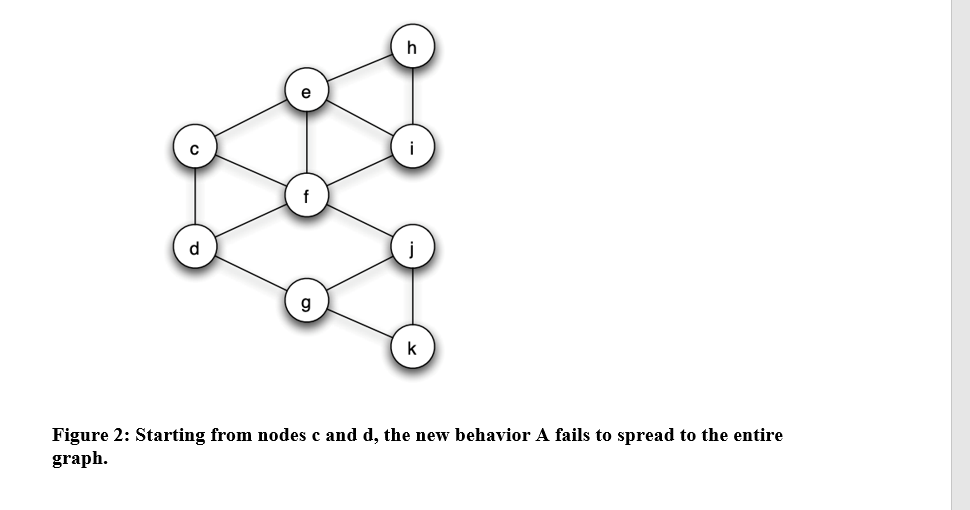Consider the decision model/game theoretic model from Chapter 19 for the spread of a new behavior through a social network. Suppose we have the social network depicted in Figure 2; suppose that each node starts with the behavior B, and each node has a threshold of q = 2/5 for switching to behavior A. Now, let c and d form a two-node set S of initial adopters of behavior A. If other nodes follow the threshold rule for choosing behaviors, which nodes will eventually switch to A? Give a brief (1-2 sentence) explanation for your answer. Find a cluster of density greater than 1 − q = 3/5 in the part of the graph outside S that blocks behavior A from spreading to all nodes, starting from S, at threshold q. Give a brief (1-2 sentence) explanation for your answer. Suppose you were allowed to add a single edge to the given network, connecting one of nodes c or d to any one node that it is not currently connected to. Could you do this in such a way that now behavior A, starting from S and spreading with a threshold of 2/5, would reach all nodes? Give a brief explanation for your answer.
Consider the decision model/game theoretic model from Chapter 19 for the spread of a new behavior through a social network. Suppose we have the social network depicted in Figure 2; suppose that each node starts with the behavior B, and each node has a threshold of q = 2/5 for switching to behavior A. Now, let c and d form a two-node set S of initial adopters of behavior A. If other nodes follow the threshold rule for choosing behaviors, which nodes will eventually switch to A? Give a brief (1-2 sentence) explanation for your answer. Find a cluster of density greater than 1 − q = 3/5 in the part of the graph outside S that blocks behavior A from spreading to all nodes, starting from S, at threshold q. Give a brief (1-2 sentence) explanation for your answer. Suppose you were allowed to add a single edge to the given network, connecting one of nodes c or d to any one node that it is not currently connected to. Could you do this in such a way that now behavior A, starting from S and spreading with a threshold of 2/5, would reach all nodes? Give a brief explanation for your answer.
COMPREHENSIVE MICROSOFT OFFICE 365 EXCE
1st Edition
ISBN:9780357392676
Author:FREUND, Steven
Publisher:FREUND, Steven
Chapter10: Data Analysis With Power Tools And Creating Macros
Section: Chapter Questions
Problem 5EYW
Related questions
Question
- Consider the decision model/game theoretic model from Chapter 19 for the spread of a new behavior through a social network. Suppose we have the social network depicted in Figure 2; suppose that each node starts with the behavior B, and each node has a threshold of q = 2/5 for switching to behavior A.
- Now, let c and d form a two-node set S of initial adopters of behavior A. If other nodes follow the threshold rule for choosing behaviors, which nodes will eventually switch to A? Give a brief (1-2 sentence) explanation for your answer.
- Find a cluster of density greater than 1 − q = 3/5 in the part of the graph outside S that blocks behavior A from spreading to all nodes, starting from S, at threshold q. Give a brief (1-2 sentence) explanation for your answer.
- Suppose you were allowed to add a single edge to the given network, connecting one of nodes c or d to any one node that it is not currently connected to. Could you do this in such a way that now behavior A, starting from S and spreading with a threshold of 2/5, would reach all nodes? Give a brief explanation for your answer.

Transcribed Image Text:k
Figure 2: Starting from nodes c and d, the new behavior A fails to spread to the entire
graph.
Expert Solution
This question has been solved!
Explore an expertly crafted, step-by-step solution for a thorough understanding of key concepts.
This is a popular solution!
Trending now
This is a popular solution!
Step by step
Solved in 2 steps with 3 images

Recommended textbooks for you

COMPREHENSIVE MICROSOFT OFFICE 365 EXCE
Computer Science
ISBN:
9780357392676
Author:
FREUND, Steven
Publisher:
CENGAGE L

COMPREHENSIVE MICROSOFT OFFICE 365 EXCE
Computer Science
ISBN:
9780357392676
Author:
FREUND, Steven
Publisher:
CENGAGE L